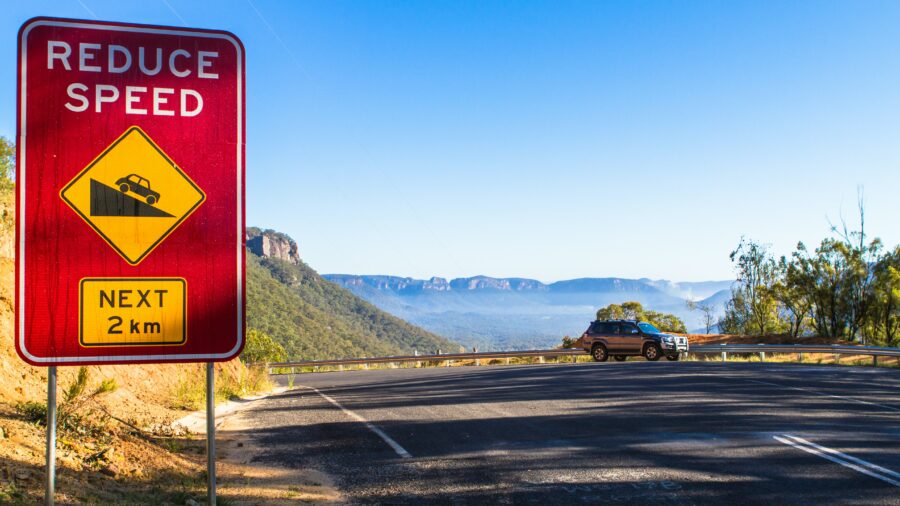More people die on country roads than in the cities. Why? Country roads are more likely to be narrow, unsealed, potholed, or have deep ditches. Drivers tend to travel longer distances and are more prone to accidents in poor weather or with wild animals. Find out how to stay safe on country roads.
More people die on country roads
Two thirds of Australians live in cities, yet over two thirds of deaths happen on remote and rural roads. In fact, the death rate is 9 times higher on remote roads than on city roads. Unfortunately, conditions on country roads can be more hazadous:
- Travelling distances are longer.
- Roads can be narrow, potholed or unsealed with deep ditches.
- Heavy agricultural and mining vehicles are more common.
- Drivers tend to travel at higher speeds.
- There are unexpected sightings of wild animals.
In NSW, more than twice (69%) as many deaths were on country roads than on city roads.
| Deaths | Year to October 2023 | Year to October 2022 | 3-year average 2020-2022 |
| City | 84 | 65 | 90.7 |
| Country | 185 | 148 | 191 |
| Difference | x 2.2 more | x 2.3 more | x 2.1 more |
So it makes sense to be more prepared when driving on country roads, particularly if you usually drive in the city.
Consider long distances, isolation and phone reception
First, safety depends on much more than the conditions of the roads. There may be hundreds of kilometres of unchanging desert or bushland and towns or villages can be a long way apart. You need to carry a store of water, food and fuel.
You can’t ever rely on having mobile phone reception and may need to carry a physical copy of, say, any maps or personal identification.
Drive slowly on narrow, gravel, unsealed roads
Country roads are more likely to be unsealed, gravel, potholed or just narrow. Some are effectively only one lane and many have blind corners. Unfortunately, unsealed roads are more susceptible to sudden changes in weather. In heavy rain or high winds, you have to drive slowly and be careful not to go over fallen branches or slide on stones.
Sometimes country roads near creeks will easily flash flood. If the water is too deep or fast flowing, avoid going through it.
Look out for heavy machinery
It’s more common to find slow-moving, heavy agricultural or mining machinery on rural roads. These vehicles are usually longer and wider than others and they have to travel more slowly along narrow roads and around corners. Look out for signs to warn you about the chances of seeing these vehicles, for example, near a gravel pit or at harvest time.
Watch out for wildlife
You’re far more likely to see wild animals on rural roads, whether it’s a kangaroo, wombat or a snake. NSW roads are the most dangerous in Australia for animal accidents. Sometimes there are signs to warn you about the chances of seeing wildlife on the roads. If you’re travelling at dawn or dusk, be mindful of these animals. If an animal does block your path, it is best to brake rather than swerve. Running off the road is more likely to cause serious injuries to you and your passengers.
Also more common on rural roads are slow-moving cattle, sheep or horses. Meanwhile, cattle grids can cause serious damage to your car if you don’t slow down for them.
Be cautious when visibility is poor
Visibility can be poor on country roads. They’re more susceptible to bushfires, smoke from local burn-offs, and thick fog in the valleys or mountains. Cars travelling in front of you may kick up clouds of dust or dirt over your windscreen. Dust and dirt can even settle in potholes and make them appear to be flatter than they are. Once again, be extra cautious when visibility is poor.
Don’t drive tired
One of the biggest killers on country roads is driving tired. Some well-known signs are frequent yawning, blinking, losing concentration, and driving too quickly. Always start a long journey well rested and plan your trip to include rest areas, food and drinks. It’s recommended never to drive for more than 8 hours in one day.
Drive to the conditions of the road
Perhaps the best advice for safety is to drive to the conditions of the road. It’s easy to blame driving conditions in the country – long distances, potholes, ragged edges, poor lighting. There never seems to be enough funding for the 680,000 kilometres of roads in Australia. But does it make sense to blame a road when a good driver always drives to the conditions of the road?
Good drivers arrive home safely and get cheaper green slips.


your opinion matters: